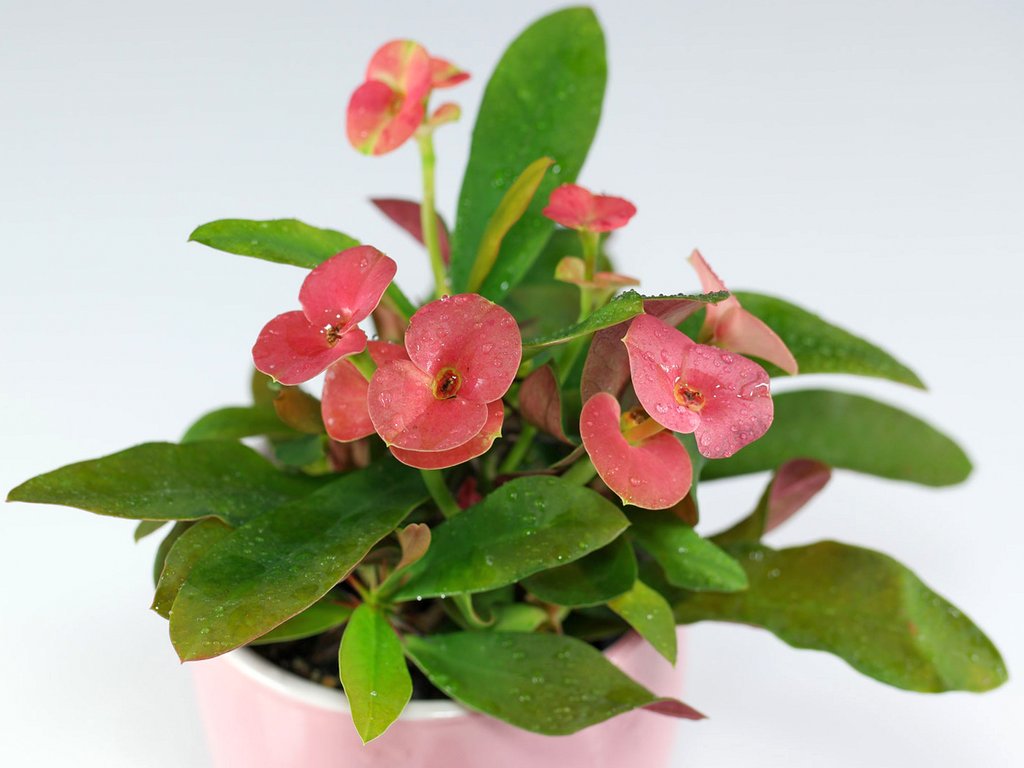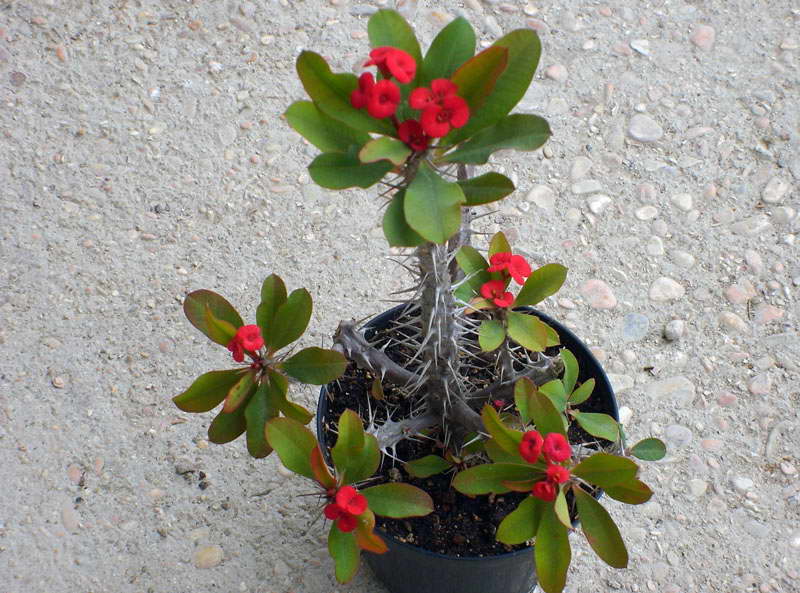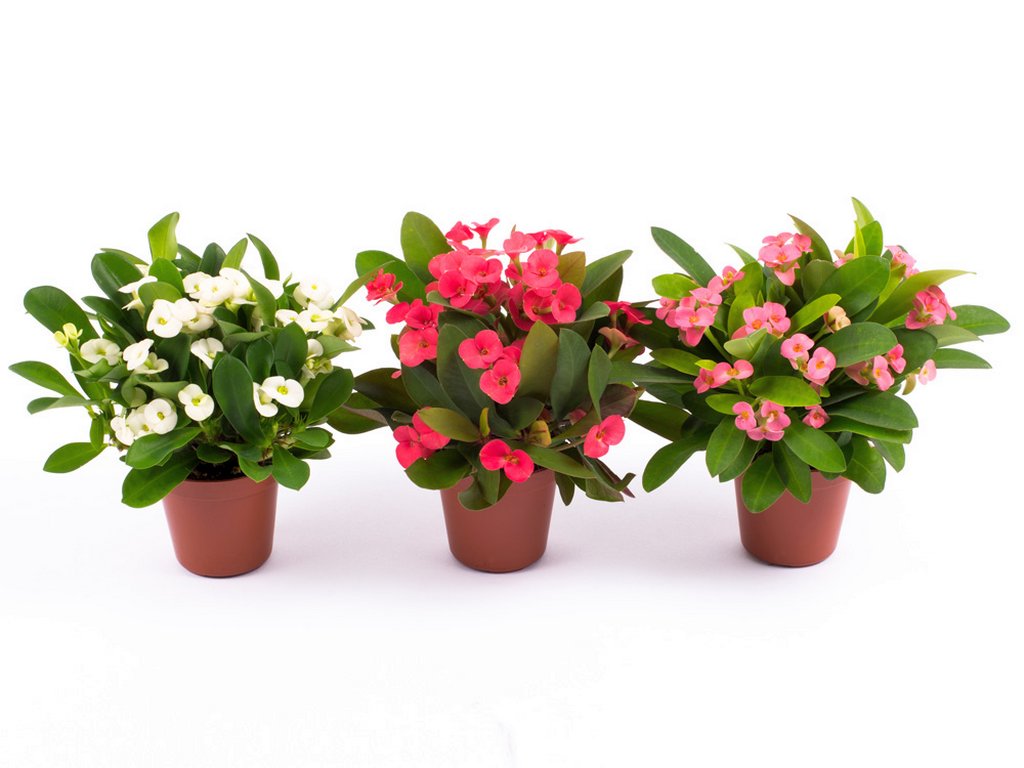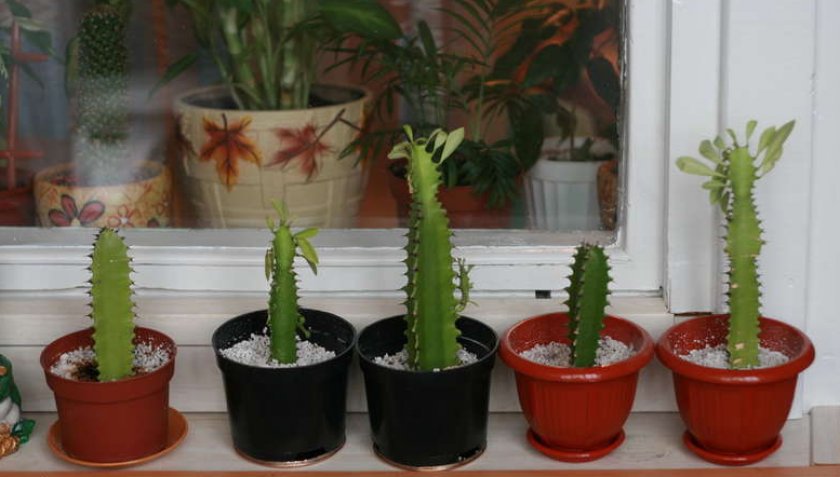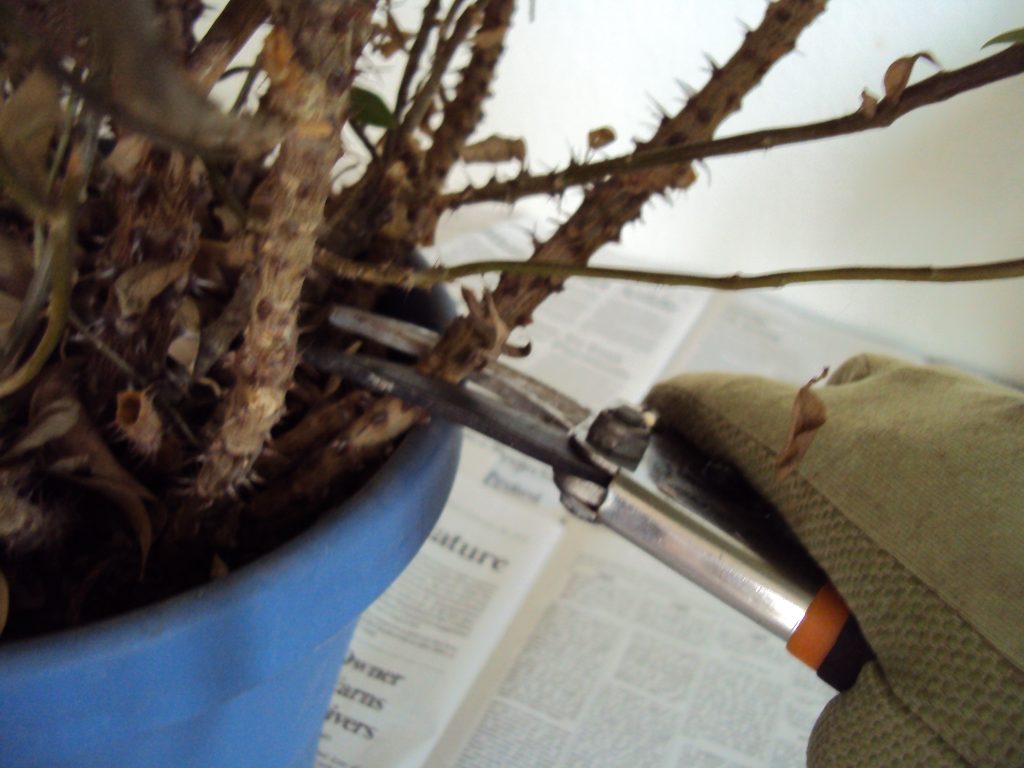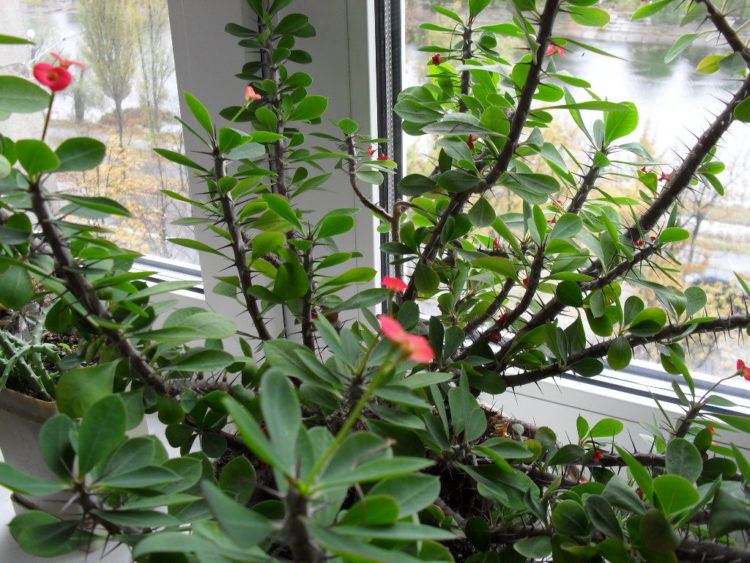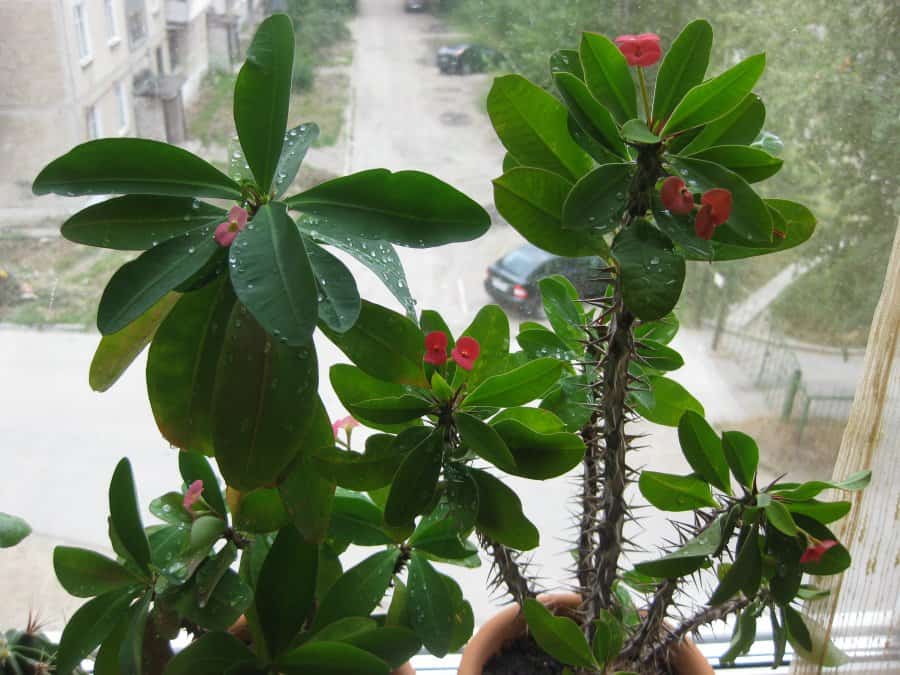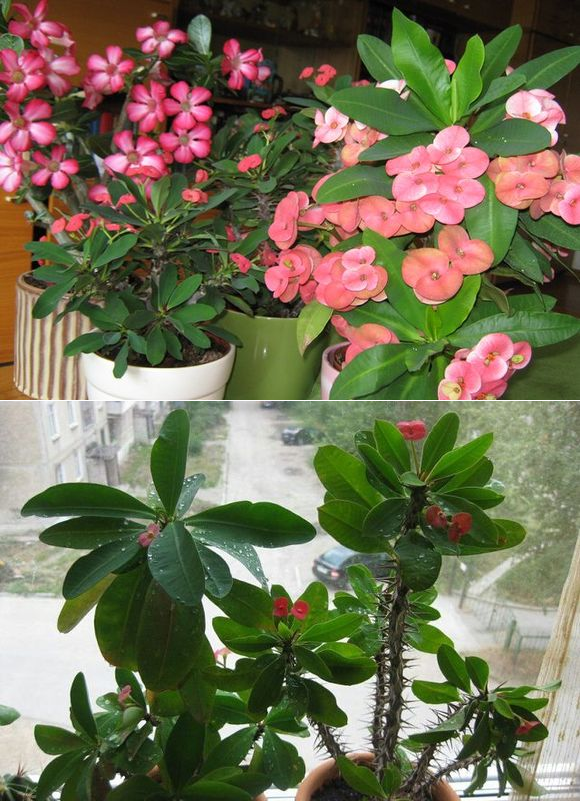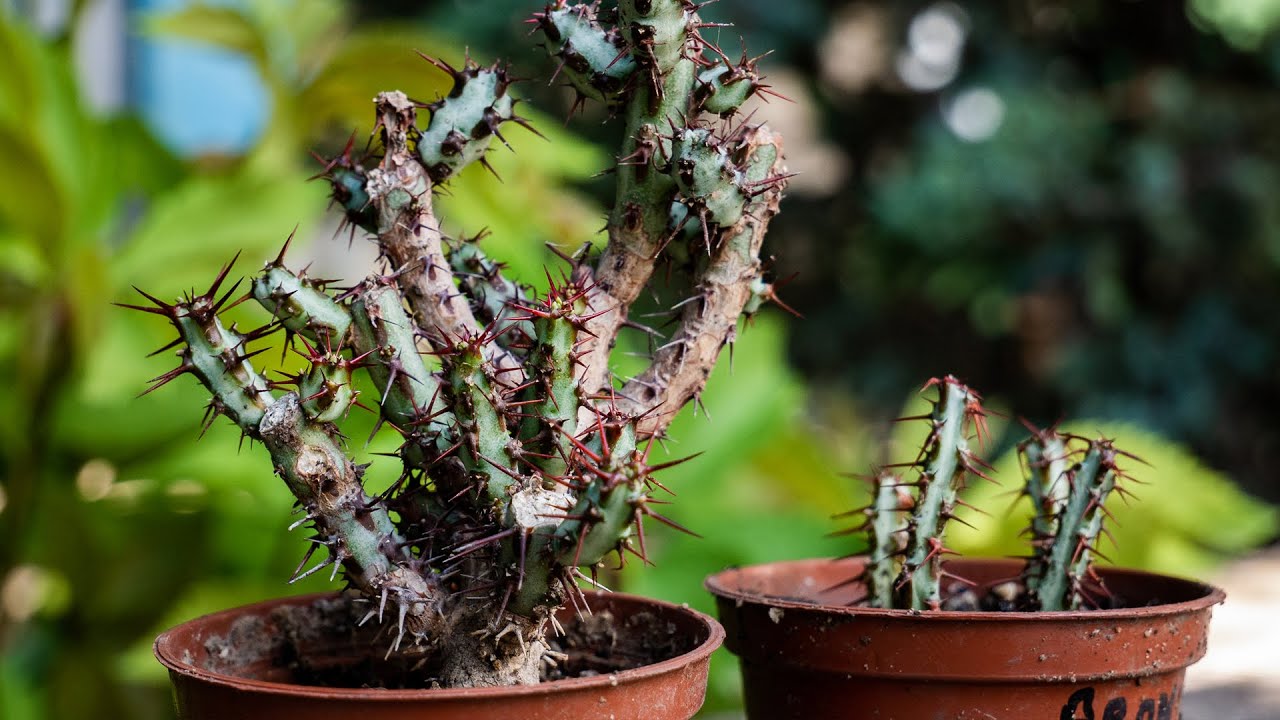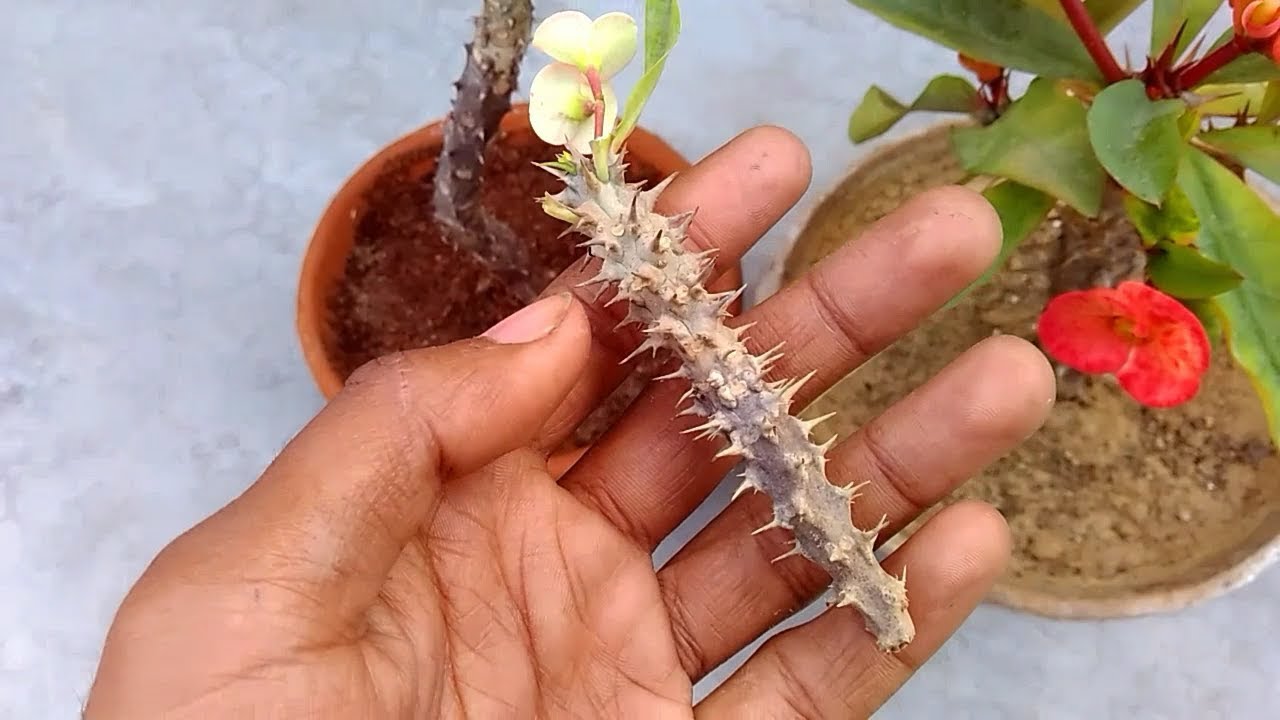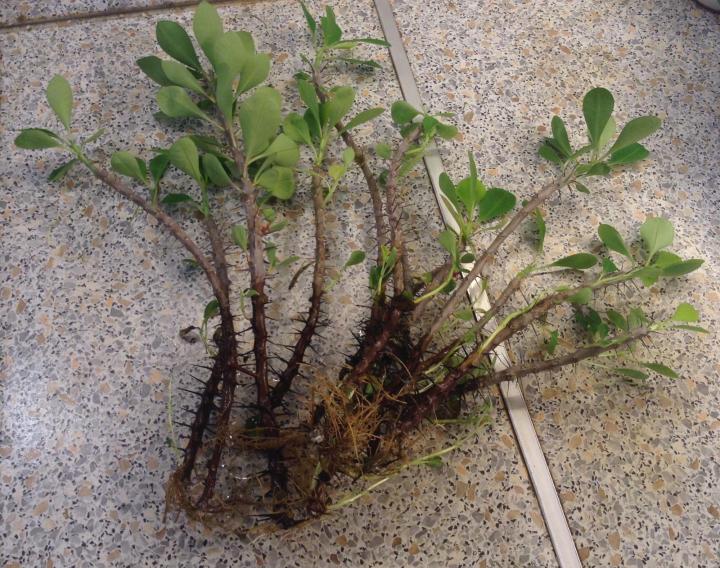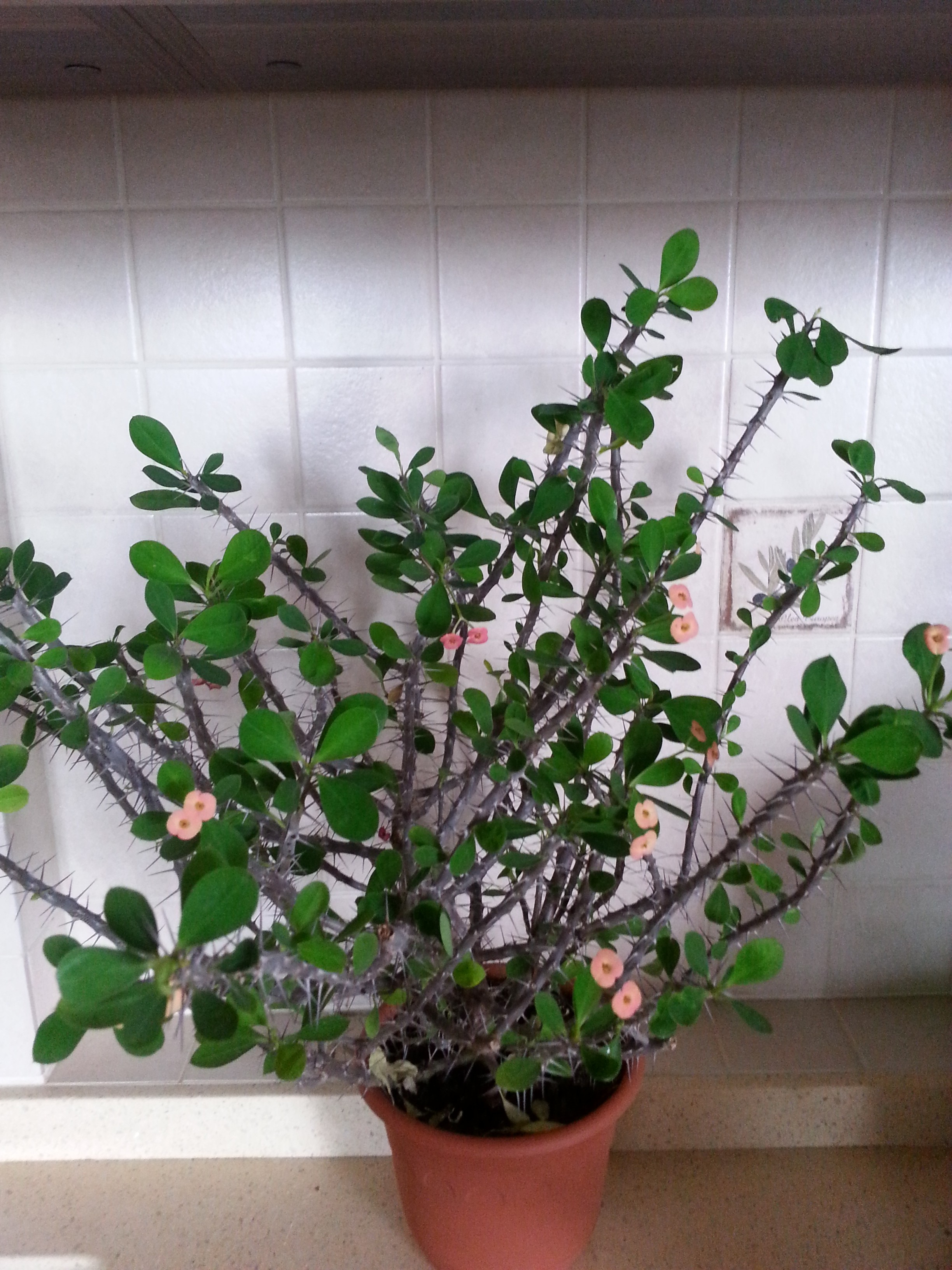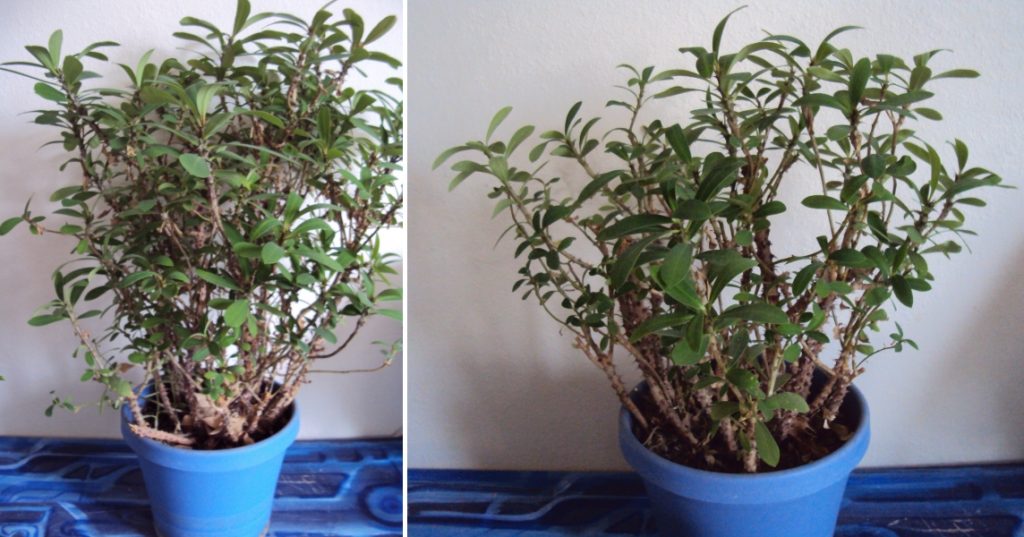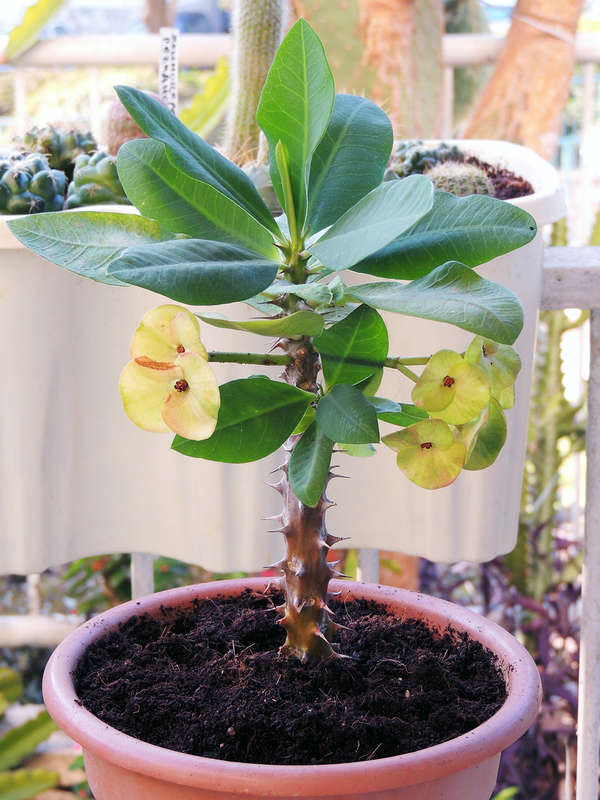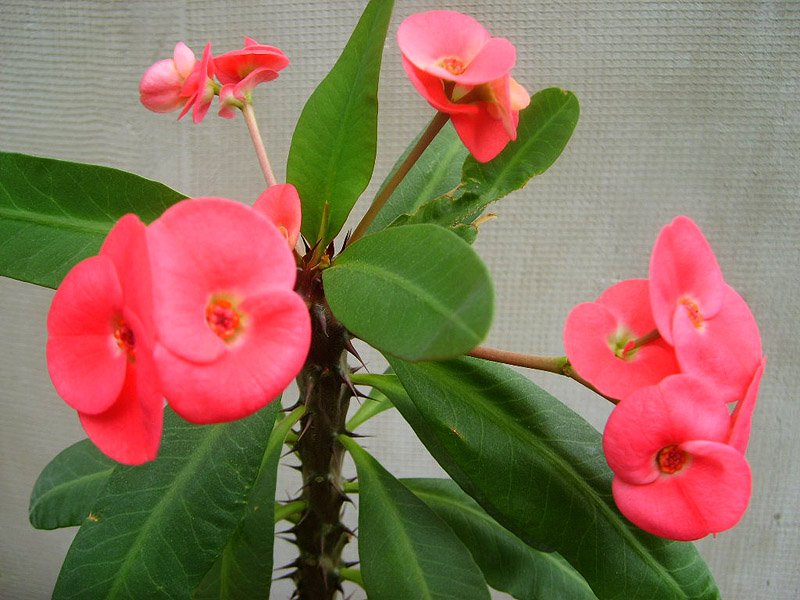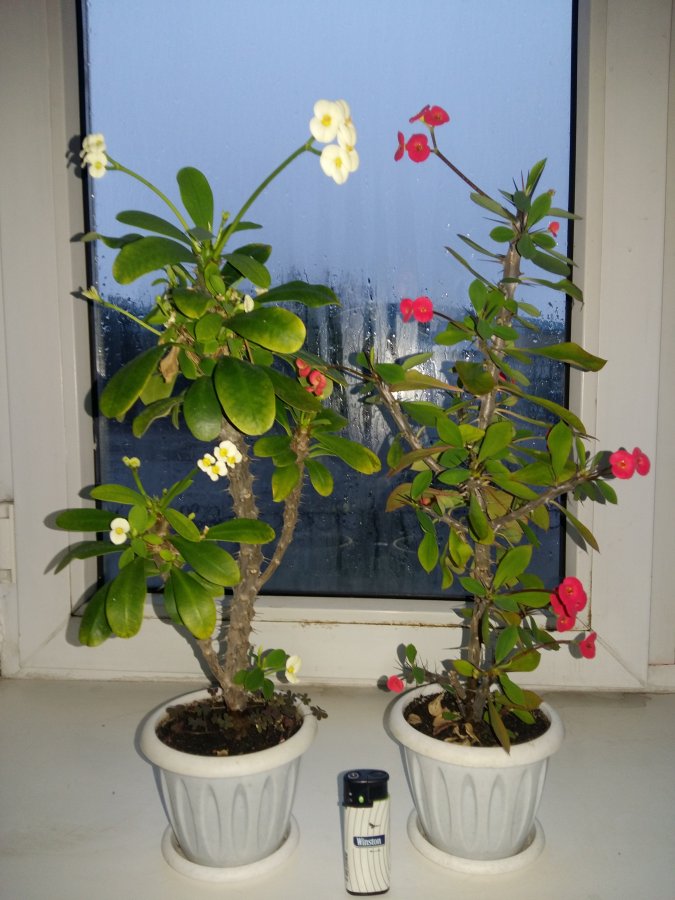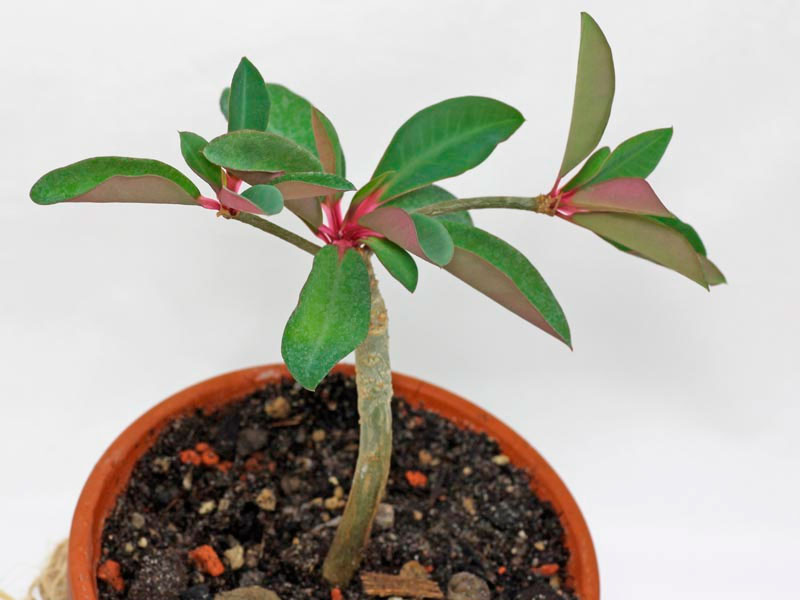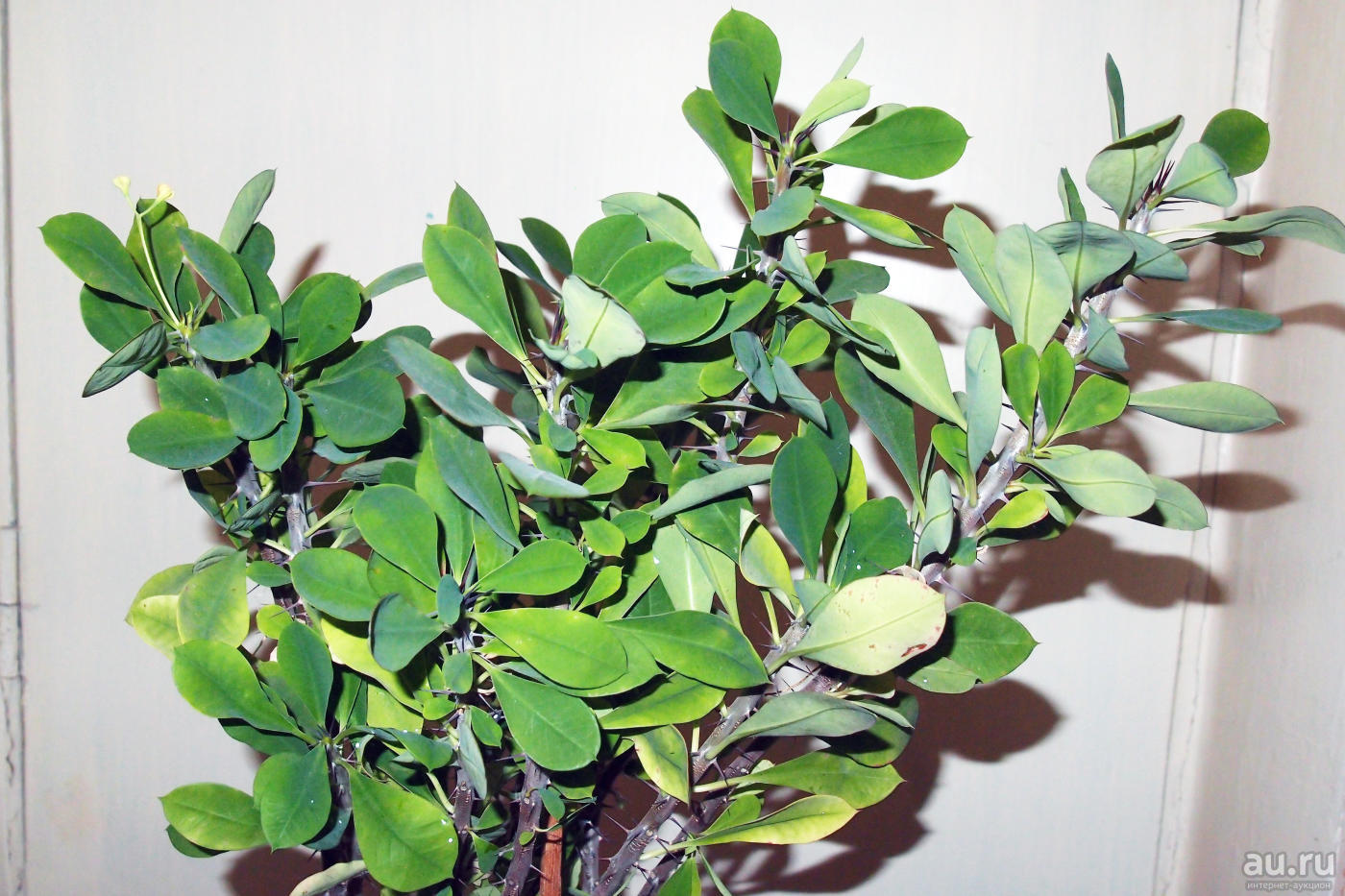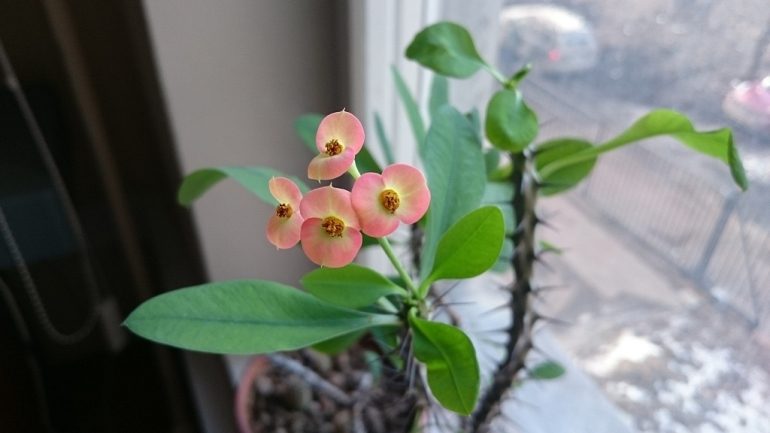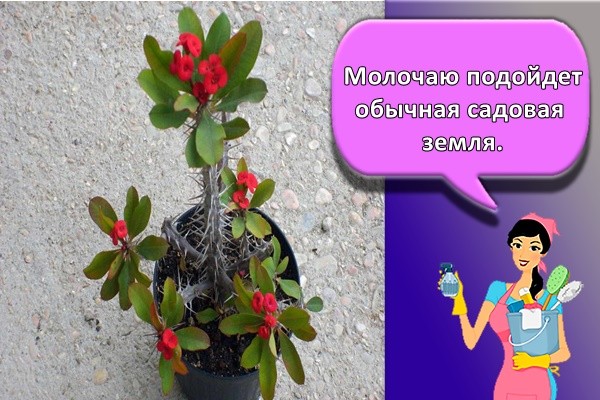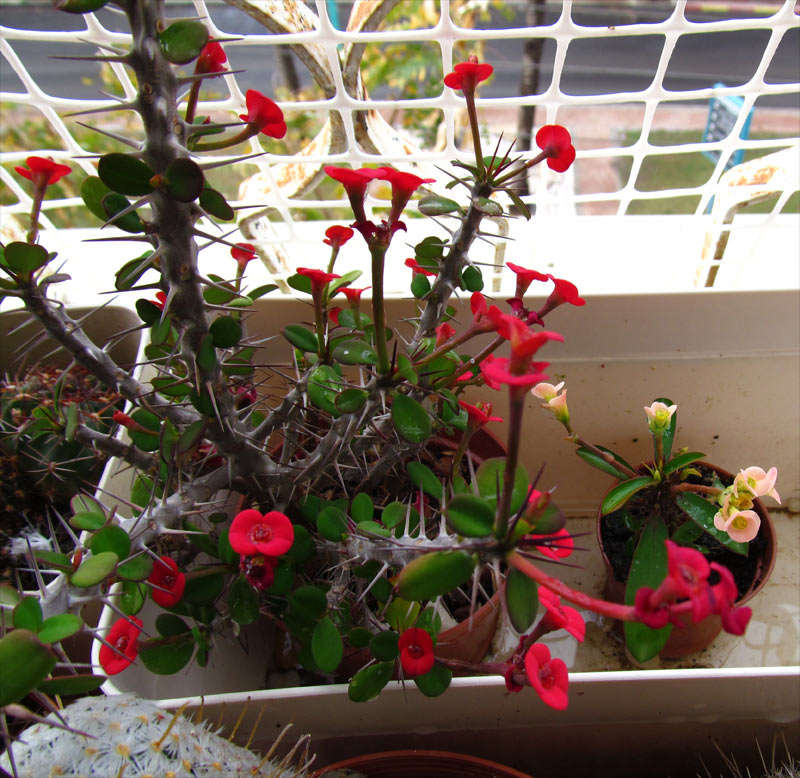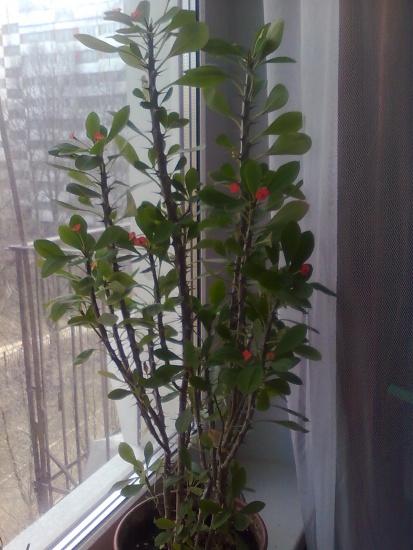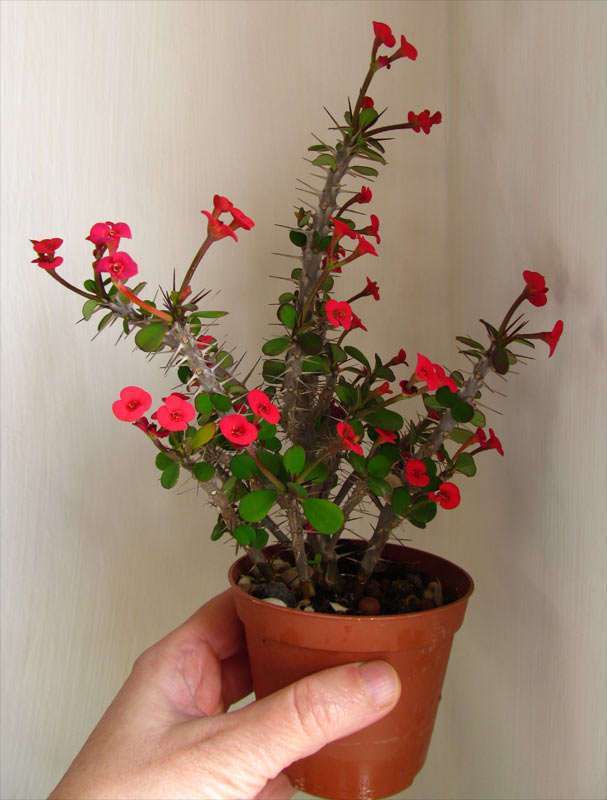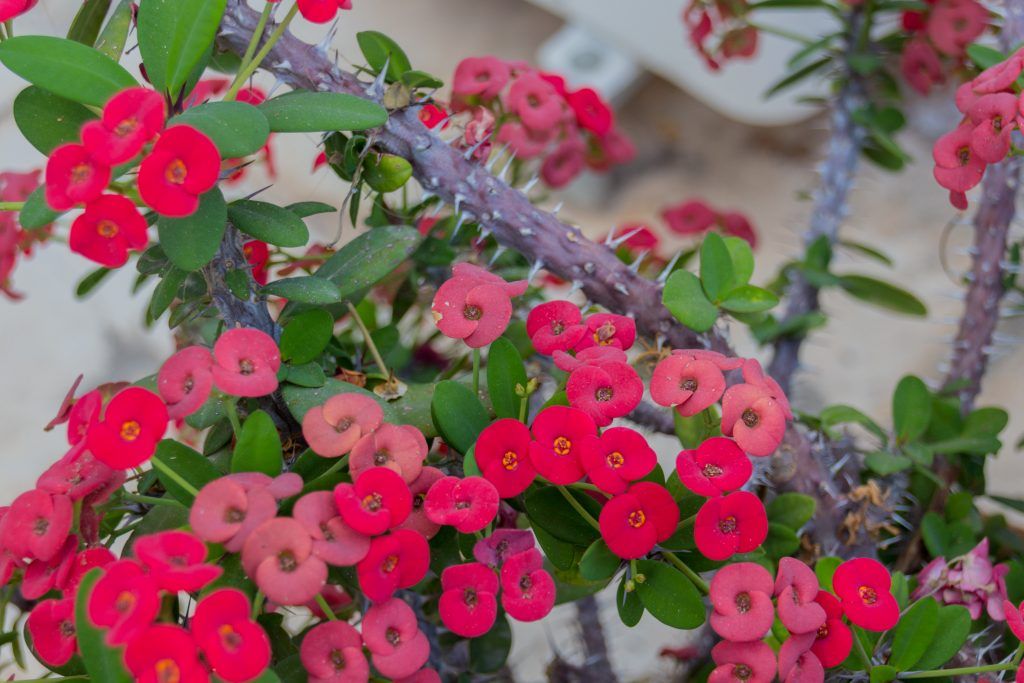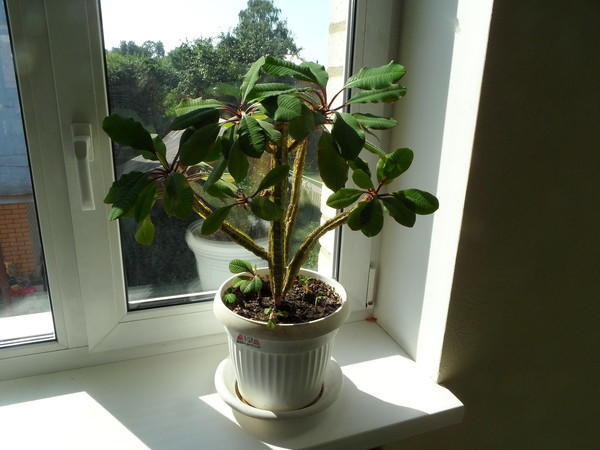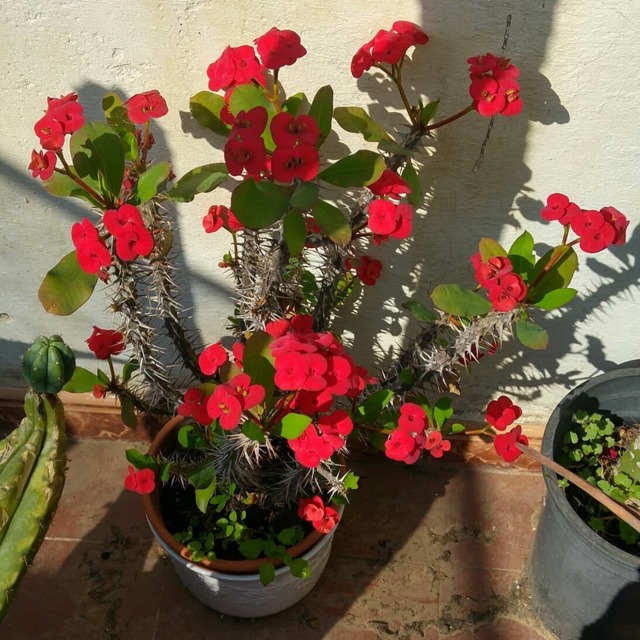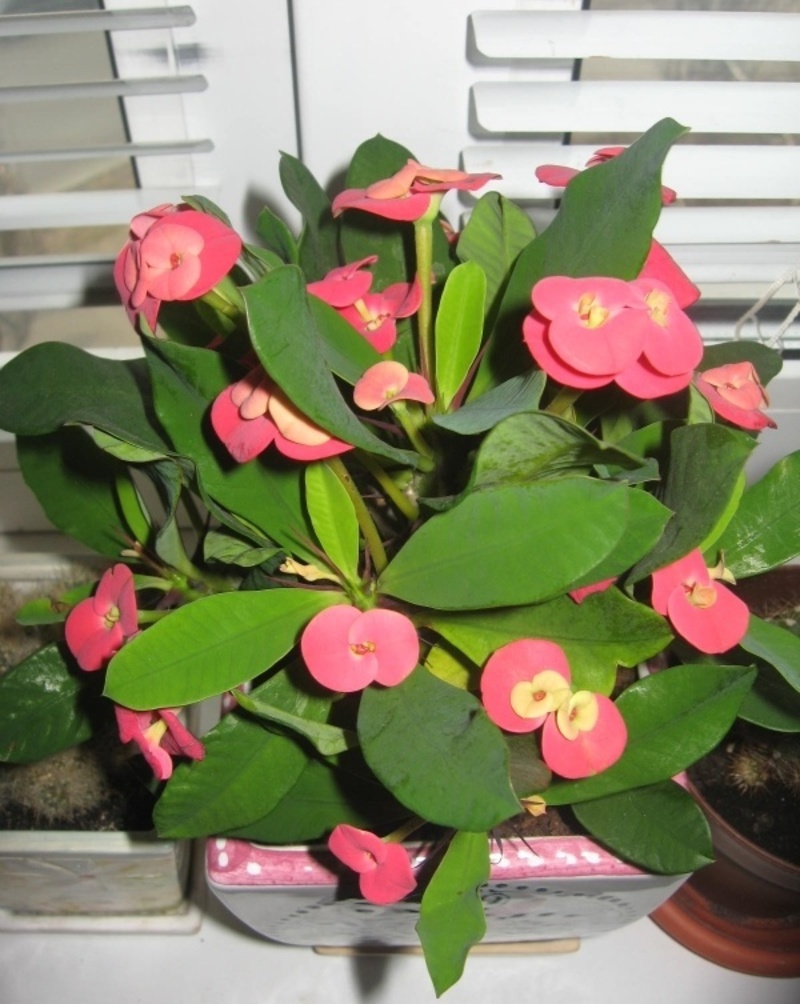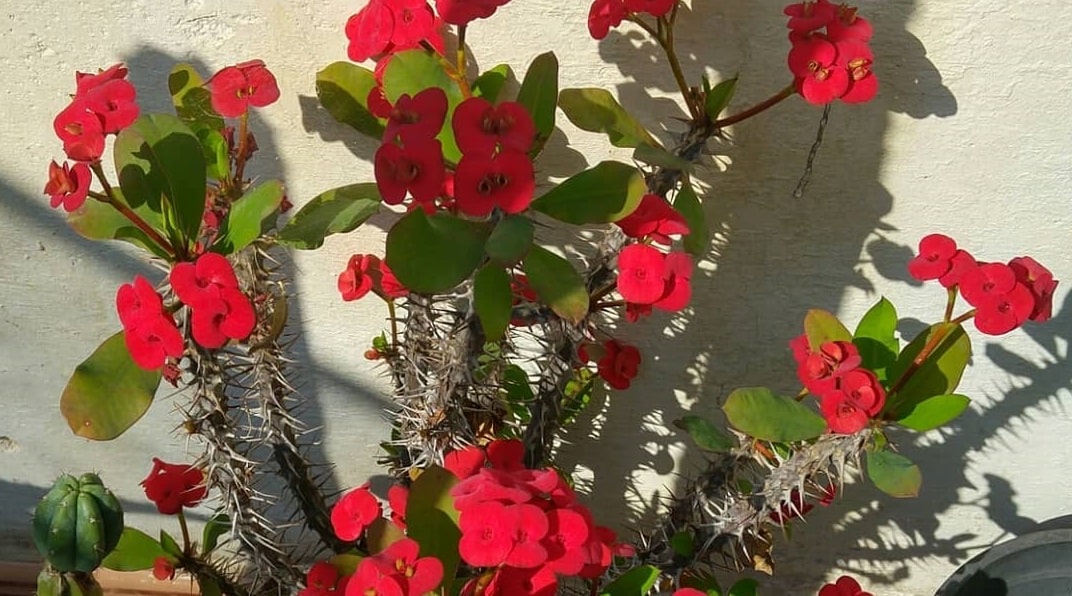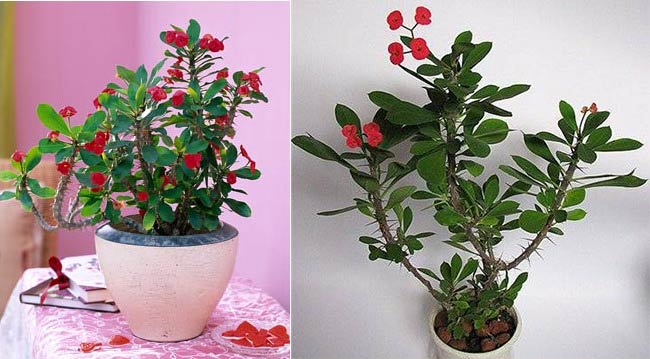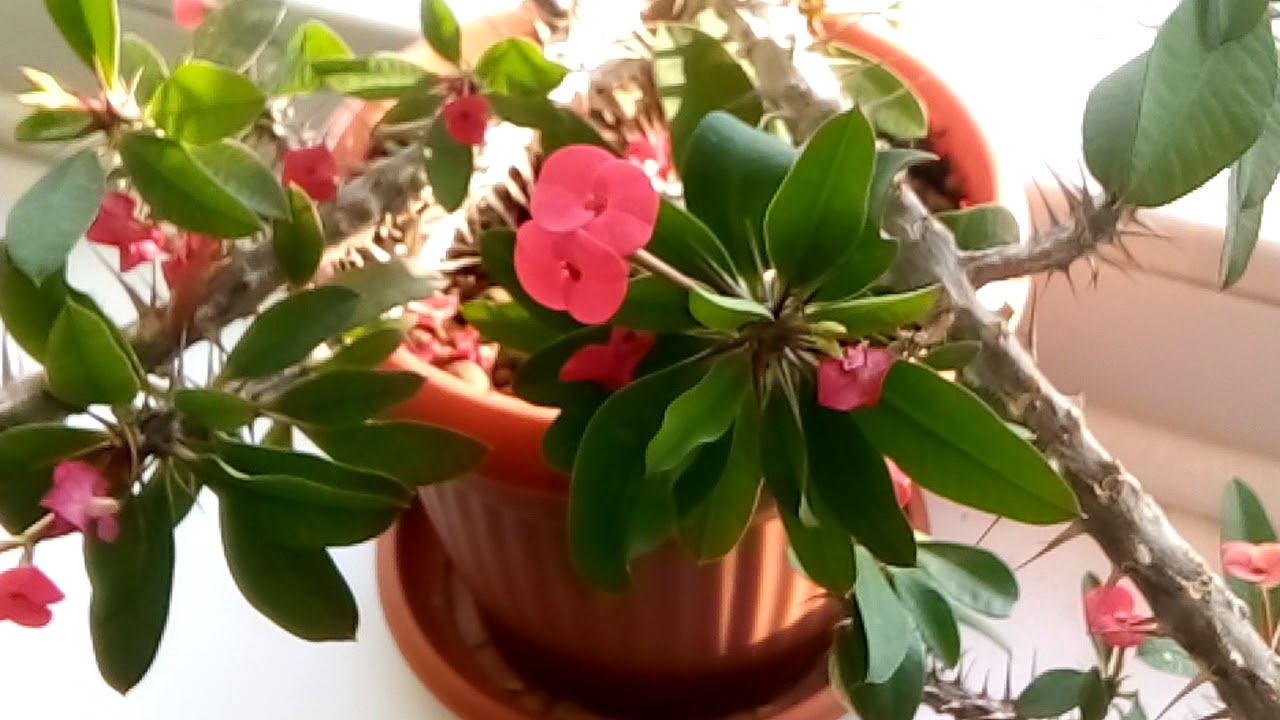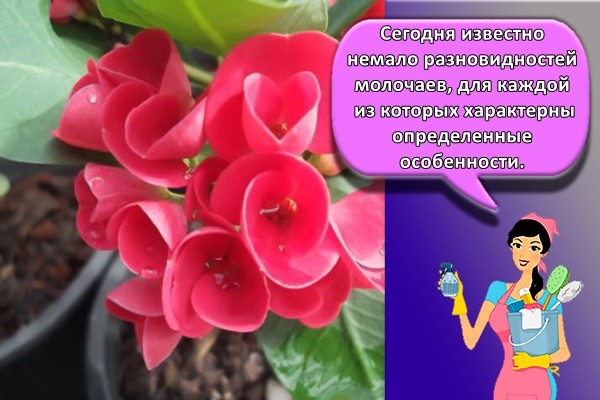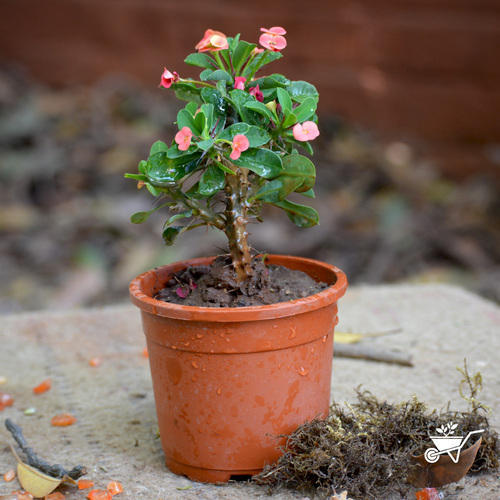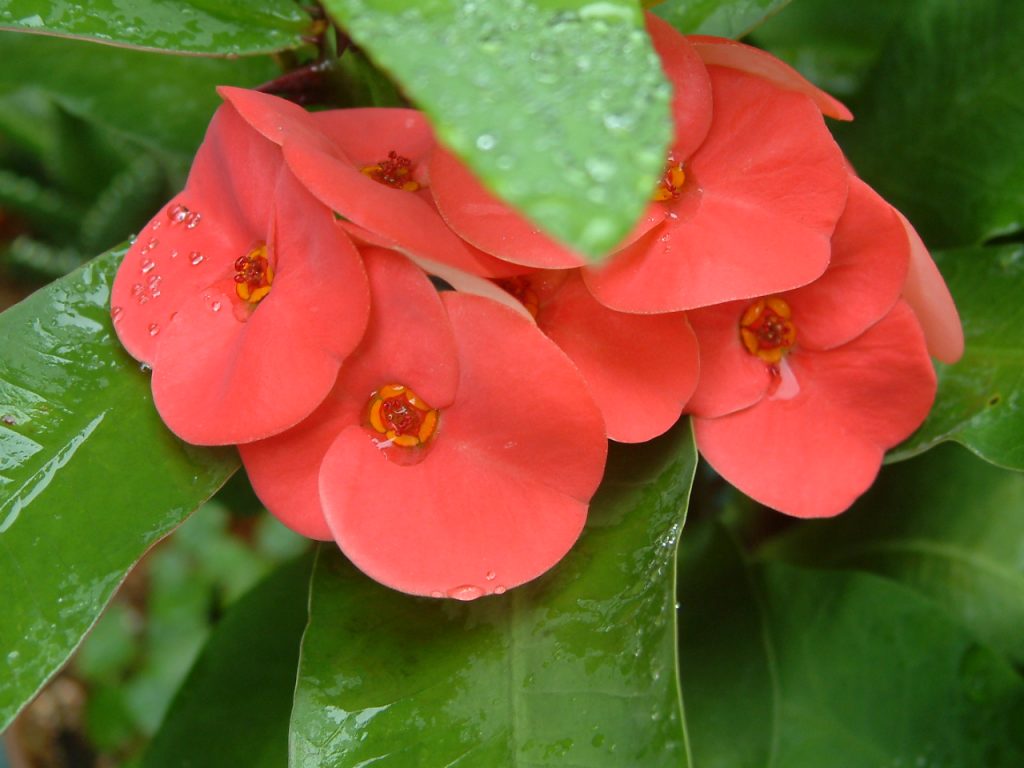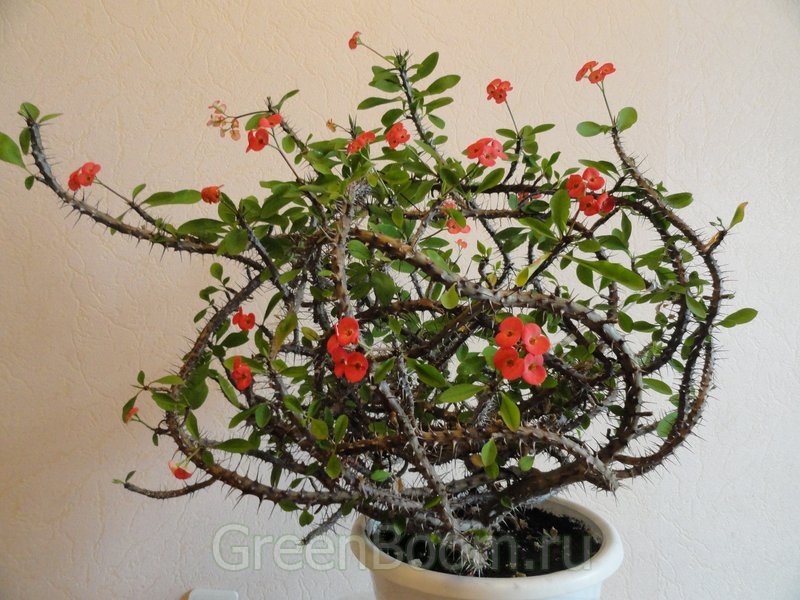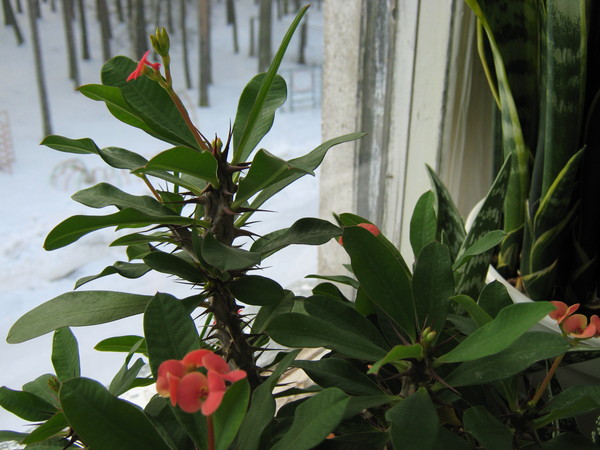Possible growing difficulties
Growing a plant indoors, there are no particular difficulties. Given that it is a succulent, watering can be limited - the bush will feed on its own reserves.
Why does not it bloom
Lack of flowering signals problems. In the case of succulents, the cause of the disturbance in the flowering phase is excessive watering or insufficient lighting of the bush. It is necessary to rearrange the pot to a warmer windowsill and adhere to the watering rules.
It will also be interesting for you to find out why the Decembrist does not bloom.
Diseases
Milkweeds are not too susceptible to diseases, but some ailments do not bypass them. Most often, the plant is attacked by fungi.

Among them:
- Alternaria Causes concentric spots on foliage, which are treated with fungicides such as Ridamil Gold or Skor.
- Gray rot. Brown and gray putrefactive spots spread on the stems and leaves, which need to be treated with the fungicides Vitaros, Fundazol, Rovral.
- Stem rot. It can develop all over the stem and down to the roots. It is treated with systemic drugs "Previkur" or "Ridomil".
- Bacteriosis Occurs with mechanical damage to the bush. Good care will be needed, including removing damaged parts.
- Euphorbia mosaic. The color of the mosaic type appears on the leaves, the leaf blades can grow unevenly. You can avoid the disease by using carefully examined cuttings for reproduction (only healthy ones are suitable).
Important! If there is no possibility of replacing the soil, the old soil can be calcined. Then it is fertilized and used again.
This applies not only to milkweed care.
Pests
Pests do not bypass Mil's euphorbia. The main harmful insects and methods of dealing with them:
- Aphid. Red, pink and lemon-colored insects are able to eat juicy leaves, which lose their color and crumble. The bush is carefully examined, the parasites are washed off with water or removed by hand, and the most affected leaves or parts of the plant are completely removed.
- Whitefly. This small midge can cause serious damage. Its green larvae are located on the lower part of the foliage, sucking the juice out of it. To combat these pests, you need to treat the bush with insecticides "Aktellik", "Fufanon", "Intavir" twice a week. Affected leaves are removed.
- Spider mite. This insect is clearly visible when inspecting the plant. You need to remove it from the foliage with a stream of warm water, having previously protected the soil from waterlogging. If the mite colony has become massive, then the pot is treated with insecticides for succulents.
- Mealybug. Shoots, leaves, and roots look like they've been sprinkled with flour. When symptoms appear, it is necessary to take the following measures: treat the roots with a solution of an insecticide for cacti, transplant the bush into a new substrate and a new pot. Fertilize the soil and water abundantly.
Pruning
It is recommended to perform this procedure after the end of the flowering period. In a greenhouse, the timing may get lost, but usually this period falls in the fall. The tops of strongly elongated shoots must be cut off. In addition, dry leaves and shoots are cut. The result is a beautiful and compact bush.
In the spring, you can repeat the procedure. In this case, you need to remove the renewed shoots. This way you can achieve abundant flowering. Of course, some growers ignore this rule, but as a result, the bush is not the most accurate. Large-flowered spurge Mila is a real decoration of your windowsill.

We provide home care
It is not at all necessary to look after the plant daily.Euphorbia Milli does not need close and constant care. But in order to get a flowering shrub, you will have to follow simple rules of agricultural technology.
Watch a video on how to care for milkweed at home.
What soil to plant
In the wild, Mile grows on the rocky soils of the tropical island. For growing a flower at home, soil from a garden or a mixture made in equal parts from peat, fertile, loose earth and sand is suitable.
If it is not possible to prepare your own soil mixture, then the soil for growing cacti from a flower shop is quite suitable for milkweed.
Site selection and lighting
To place a pot or flowerpot with a plant, window sills or special racks on the south side of the room are most suitable.
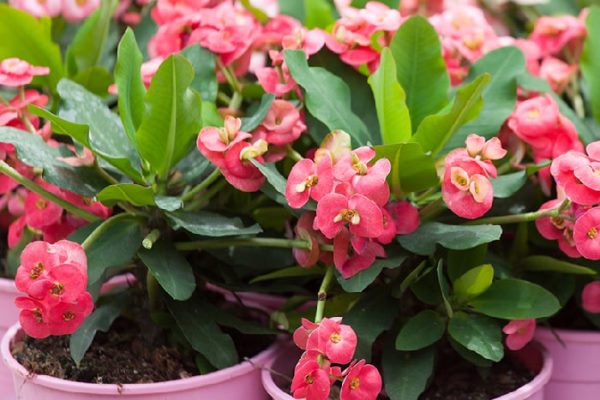
Euphorbia loves sunlight. Only with good lighting will the bush grow and develop, and its lack leads to stretching and thinning of the trunk and branches, the leaf plates turn yellow and fall off, and the flowering period does not come.
Humidity and temperature
Compliance with the temperature regime is very important for the cultivation of Milkweed. With sudden changes in temperature, the flower hibernates and stops developing
Optimum climatic conditions for cultivating an exotic flower are from +22 to +30 degrees. In the summer months, a pot with a plant is taken out to balconies, loggias or personal plots.
In winter, euphorbia feels great in heated rooms, even if the air in them is dry. The plant does not need increased moisture, therefore euphorbia milii does not need additional spraying.
The dust from the leaves of the plant is wiped with a slightly damp soft cloth or shaken off with a brush.
Important! Euphorbia does not tolerate strong gusts of wind and drafts. By moving the flower pot outside, provide the plant with protection from the negative influences of the external environment.
How to water Mil's euphorbia
Watering schedules for milkweed in winter and summer differ.
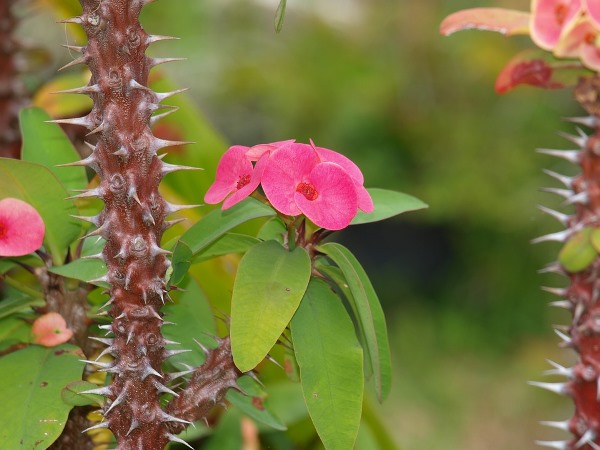
In its natural environment, the plant easily tolerates drought. At home, the flower requires abundant watering in the summer and moderate irrigation in the winter.
In the warm season, spurge is watered at least once every 5-7 days. But, at the same time, waterlogging of the soil leads to the development of fungal infections and the death of the plant.
Therefore, they wait until the topsoil dries out, and only then watered. Watering is carried out neatly, with warm, settled water, without moisture getting on the lower leaf plates.
In winter, the flower is watered based on the temperature regime and humidity in the room no more than 1 time per month.
Important! If in winter the plant is located near heating devices or radiators, the soil dries up, and Milius' spurge sheds its leaves and loses its decorative characteristics.
When and how to feed euphorbia
Although Mila is an unpretentious plant, it needs additional nutrients and minerals.
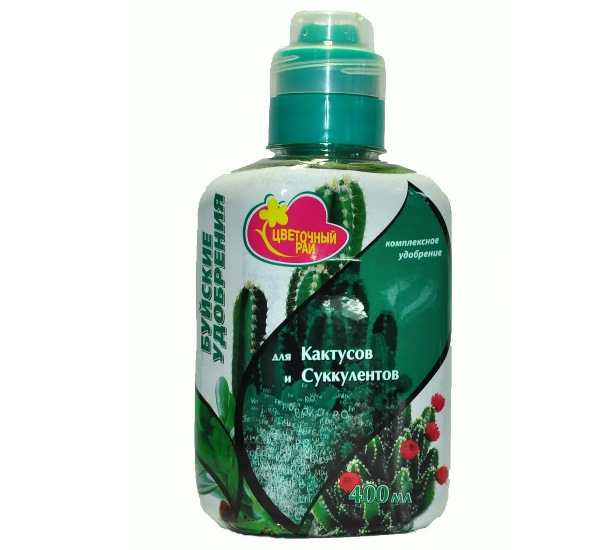
With the onset of spring, mineral complex fertilizers for succulents or cacti are added to the soil. Events are held no more than once a month and end in the fall. In winter, the flower does not need fertilizing and fertilization.
How to prune Mille spurge?
With the onset of spring, the longest branches of the bush are shortened by half. Such an event stimulates the growth of lateral shoots, the flower levels out, gains density and enters the active phase of flowering.
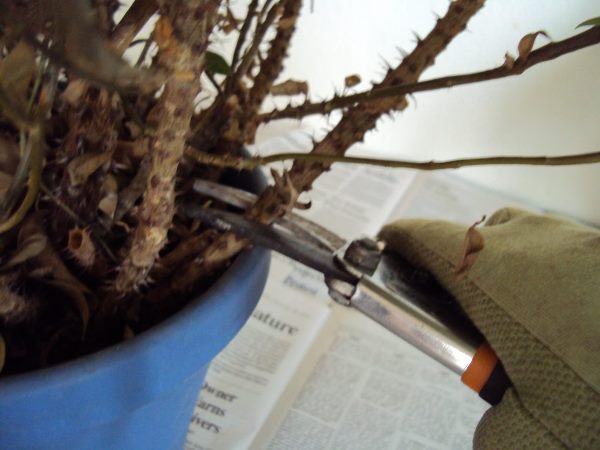
Care features
The unpretentious spurge only needs watering, provided that the hot weather persists, as well as periodic loosening of the soil and top dressing. This is enough to provide optimal conditions for flower growth.
The need for watering
The first watering is carried out at the time of planting, the first two weeks must be monitored so that the topsoil does not dry out. Otherwise, the seedling may not take root.
There is no irrigation schedule, the procedure is performed when the earth dries up.In a wet rainy summer, you don't need to water the plant at all. If the topsoil becomes whitish, cracks, it is loosened and at least 5 liters of water are applied under one bush.
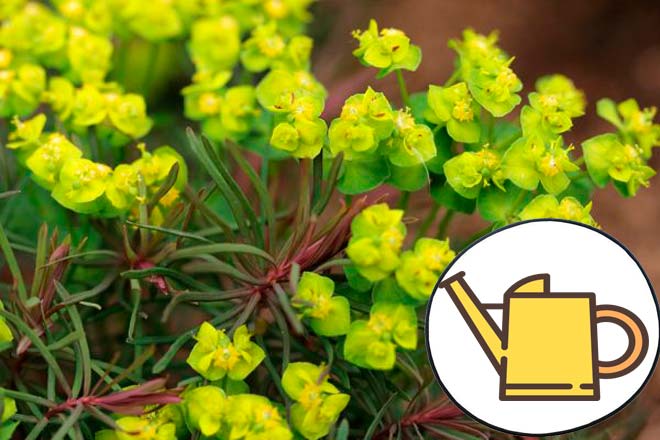
It is imperative to control the amount of water introduced. Even a slightly increased soil moisture leads to the fact that the root system begins to rot, gradually the process spreads to the stems and leaves. This can be seen when the flower becomes soft, individual shoots fall on the ground, the leaves are pressed against the stems.
Top dressing
Fertilization is carried out twice a month. Use mineral mixtures for succulents or complex formulations. Indoor plant food is also suitable.
The first top dressing with a break of 14 days is applied at the end of May and at the beginning of summer. With increased acidity of the soil, in addition to dressing, it is recommended to add lime to the soil.
Pests and diseases
Euphorbia is practically not susceptible to diseases. With waterlogged soil or high moisture content in the air, rotting may begin, which weakens the immune system and leads to the development of bacteriosis and other diseases. But with proper care, this option is almost impossible.
If you find soft putrid spots of a dark shade on the leaves or trunk, stop watering, if necessary, build a moisture drain from the area where the flower grows.
Pests also bypass the euphorbia, but the plant attacks aphids. Its colonies are visible at the base of the trunk and on the back of the leaves. Signs of damage are foliage curling, yellowing or lack of shoots, unhealthy appearance of the plant.
Of the natural methods for controlling aphids, a soapy solution used for spraying is suitable. Also used ready-made insecticides - Fitoverm, Aktellik.
Reproduction methods
Euphorbia reproduces in three ways:
- The division of the bush can be used in March-April, when the buds have just appeared, or in September, so that the plant has time to take root over the winter. You can divide any parts, but each of them must have at least one healthy kidney. During such a transplant, the flower regains its shape in 1-2 years.
- It is much more effective to divide the spurge by cuttings, since an adult bush has many healthy shoots. You can select them both before and after flowering. Before planting, put the stalk in water to drain the juice, dry the ends, stick it into the open ground, cover with cut plastic bottles.
- In spring, spurge produces many seedlings. After they get stronger, they can be dug up and transplanted to a permanent place, it is better to do this in the fall.
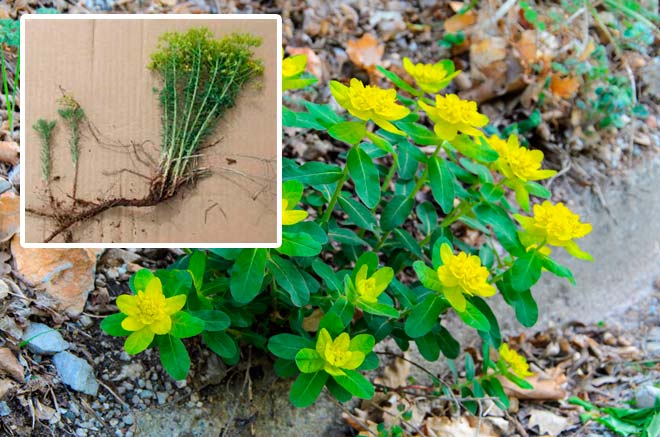
Euphorbia - landing
The planting of milkweed is as follows:
The pot must be chosen carefully and slowly.
An especially good solution would be, for example, a clay container, but plastic flowerpots would also be a good solution.
For the reason that the roots of the plant do not grow much and have a weak sucking power, it is advisable to choose a low tub.
It is important to make sure that the bottom of the pot is equipped with holes through which excess moisture can escape.
Garden spurge is planted in spring.
Soil for milkweed
It is best to buy soil for planting in a retail network that offers goods for indoor and greenhouse floriculture. In this case, it is allowed to use land prepared for cacti. You don't have to rush to spend money, since it is quite possible to compose the soil mixture on your own: if you mix rotted leaves, sand and turf soil in equal quantities. To create a drainage layer, foam blocks, expanded clay and pebbles are used. The euphorbia plant loves such soil.
How is it correct?
For cutting, you can use a sharp knife or a special garden pruner. It is necessary to prepare sterile gauze wipes, charcoal and activated carbon. And you should also take rubber gloves for circumcision so that the poisonous juice does not get on your hands.
- Rinse the knife or garden pruner well under water, wipe with alcohol (this is done in order not to infect during circumcision).
- To be sure to stop the further growth of the stems, a sharp object must be heated.
- Put on gloves and with careful movements begin to trim the tops and side branches.To the plant does not grow too high, the tops should be cut off, and in order for it not to grow in width, the number of lateral shoots should be controlled, leaving the most beautiful and growing upwards, and not to the sides ...
- After cutting, a specific juice appears, it is carefully wiped off with a sterile napkin, the cut points must be sprinkled with charcoal.
- Cuttings cut from the upper shoots can be washed under warm water (so that the juice does not interfere with the growth of the roots), then air-dried for a couple of days and sprinkled with activated charcoal in order to prevent rotting. Then root it into the cactus substrate.
- After all procedures, be sure to thoroughly wash your hands with soap and water.
Diseases and pests of milkweed
Mille spurge is resistant to disease. Difficulties can arise only due to ill-considered care. The most common disease is fungus.
Root rot is a consequence of excessive moisture in the ground.
It manifests itself in the form of falling and yellowing of the leaves. Transplant the plant into new soil right away or it will die. Also spray it with fungicide.
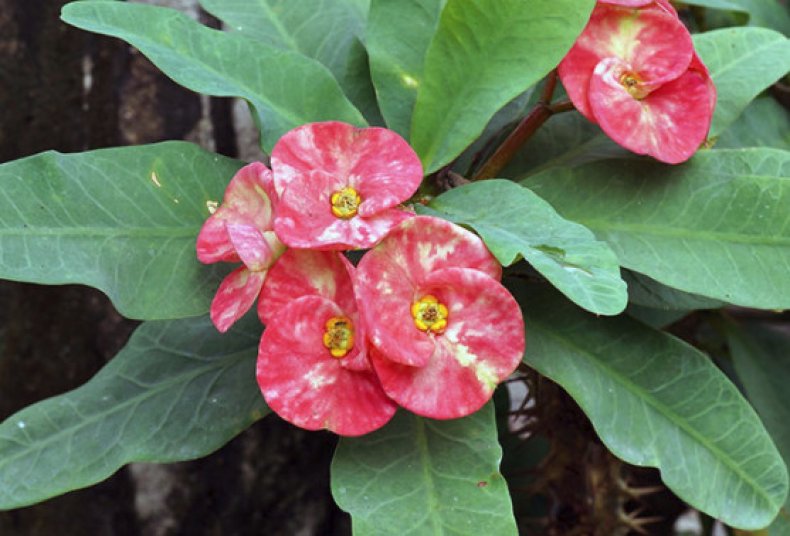
By the way, the fungus can be triggered by spraying and water droplets on the leaves. This cannot be done.
The main pests that are terrible for the flower:
- shield;
- whitefly;
- aphid;
- spider mite.
You can fight aphids and spider mites by wiping the affected areas with a soapy sponge. If this procedure does not work, use insecticidal agents: Actellik, Aktara, Fitoverm.
Read more on how to deal with spider mites and whiteflies.
Fitoverm, Fufan and Aktellik will help against whitefly. Insecticides are also needed in the case of the scabbard.
Rules for caring for white-lobed milkweed
There are some nuances associated with caring for the plant regarding the irrigation regime.
Requirements for location in the house
The plant requires certain conditions for keeping in the room, related to the temperature regime and the need for light.
Temperature
Euphorbia is a thermophilic plant. It grows best at temperatures between 18-25 ℃ above zero. However, short-term temperature drops to +15 ℃ will not do much harm to the flower. In the absence of heat (at 12-14 ℃), the plant begins a dormant period.
Important! Drafts negatively affect the condition of the room palm
Lighting
This variety of milkweed loves light, which is why experienced flower growers in the summer months are advised to take the flowerpot out to the balcony or veranda. In the afternoon, sunbathing should be avoided, as this can cause leaf burns.
A pot with a tree can be placed on the windowsill, but if the windows face the north side, then additional light from an artificial source will be required.

Lighting for milkweed
Humidity
This plant tolerates dry indoor air well - the optimum humidity is 40-50%. It is not recommended to strongly exceed these indicators.
Watering
Euphorbia white-streaked needs abundant regular watering
It is especially important to keep an eye on humidity during the hot summer months. At the same time, a number of conditions are observed:
- The earth ball should not dry out completely, as this will negatively affect the state of the root system.
- The frequency of watering is determined taking into account the temperature and humidity of the air. The indicators will be individual. The main thing is that before the next watering, the top layer of the soil has time to dry out a little.
- Soft water is used at room temperature.
- After watering, all moisture from the pan must be removed. If this is not done, the roots will start to rot.
Spraying
The white vein does not need to be sprayed, as this affects the humidity. You can remove dust from sheet plates with a soft brush or dry sponge.
Priming
The acidity of the soil should be close to neutral. For planting, you can purchase a special soil that is suitable for succulents.
You can also prepare the soil yourself. This will require several components in equal parts: calcined sand, small pebbles for drainage, peat and turf soil.
Top dressing
During the period of active growth (from the beginning or mid-March), the spurge needs regular feeding. Nutrient formulations formulated for cacti and succulents are well suited for this purpose.
Note! You need to fertilize the soil once every 2-3 weeks. At the same time, fertilizers are applied more often in the spring.
In the summertime, it can be reduced to once every 3-4 weeks.
How to care for a plant?
Lighting
One of the most important aspects of milkweed care is lighting. It should suit the plant optimally. Mile does not tolerate dark or shaded areas. Therefore, before you start this flower at home, you need to carefully choose a suitable place for it. Euphorbia Mila feels great in direct sunlight. For a flower to grow well, it needs a lot of light.
Watering
Important! At home, the plant requires special watering and air humidity.
This species is drought-resistant. Since the flower grows in a desert area, it is used to the scorching rays of the sun. And it should be watered no more than 1-2 times a week.
Be sure to wait until the soil dries out, and then carry out subsequent watering.
In winter, euphorbia rests, so the frequency of watering should be reduced. It is worth noting that this plant will better tolerate dryness than excessive moisture. Frequent and abundant watering leads to root rot. And the complete drying out of the soil threatens with yellow leaves and their fall.
Euphorbia feels great in a dry room. This is a big plus for people who have a flower in their apartment. The only thing to do is ventilate sometimes. In no case should you spray the plant, since the water on the leaves leads to the formation and development of a fungal infection.
Temperature
The most important factor in growing Milkweed Milk at home is temperature. The flower has a negative attitude towards sharp daily changes. The plant is very thermophilic. In summer, the air temperature should be at least +25 degrees. You can put the flower pot on a sunny veranda or balcony.
When cold weather sets in, the temperature should not drop by more than 10 degrees. Low rates are destructive, since the root system of Milkweed Milk is supercooled, and the flower dies.
Priming
This species is not at all picky about the soil. Euphorbia can even grow in soil taken from the garden. However, it is recommended that you buy special earth from a flower shop. Most often, they take soil for cactus succulents.
To make the soil composition yourself, you will need:
- leafy land (2 parts are taken);
- sand (1 part);
- sod land (1 part).
Pot
The pot should be slightly tapered and tall. It is covered with a drainage layer by a quarter. In the role of drainage, pebbles or expanded clay are suitable. The bottom of the pot should have large holes to drain excess moisture. Each next pot for replanting the plant should be a couple of sizes larger.
Recommendation. Choose a flowerpot proportionately - do not transplant the flower into a pot of the same size.
Top dressing
Complex preparations for succulents are often used. It is imperative to adhere to the dosage, in accordance with the instructions. Basically, feeding is needed in the summer, when the plant is actively growing. Top dressing is done only once a month
Be careful with nitrogen fertilizers! It is better not to experiment and purchase a special composition for cacti.
Pruning
How to prune plants to form the crown of a bush?
- It is worth carrying out this procedure after the euphorbia has faded.
- The pruning period is in the fall.
- The tops of the shoots are cut off first.
- Then wilted leaves and dry shoots are removed.
- A neat bush is formed.
- Pruning can be done again in the spring.
- Renewed shoots are removed. This produces abundant flowering.
Transfer
In the first year of Milkweed Milk's life, no transplant is done. Adult specimens are also not always transplanted, this should be done when the roots do not fit in the pot. This procedure goes as follows:
It is necessary to carefully remove the flower from the pot along with a clod of earth.
Further, the entire root system is cleaned. It is worth doing an inspection, if there are rotten roots, they need to be removed.
The new pot is poured over with boiling water.
A drainage layer is poured and filled with earth.
Then the earthen lump is placed in a new pot and covered with more soil on top.
Reproduction methods at home
There are several ways to breed Milkweed Milk at home. Let's take a closer look.
Seeds
The seed method is the least time consuming and fastest in terms of planting. However, the reproduction of the brilliant milkweed (as this species is often called) has a significant disadvantage: the plant completely loses all its own varietal and breeding characteristics.
You can propagate a plant of this type by seeds as follows:
- We purchase seeds in a specialized store or collect seeds ourselves from an adult bush. They should be firm to the touch, not damaged and should not be overdried.
- In a previously abundantly (but not excessively) moistened soil in a pot, place one or two seeds, pressing them a little into the soil.
- The container in which the seeds are planted in this way should be covered with glass or plastic wrap. As an alternative to film and glass, cut plastic bottles can be used.
- We put containers with our crops in a warm room, the temperature in which should not fall below + 20 ° C. This room must also be sufficiently well lit.
- After the formation of the first leaves on the seedlings, the coating should be removed from the pots.
- Watering of seedlings should be moderate.
- When the seedlings grow up, they must be planted one at a time in each pot.
Cuttings
How to root Mil's euphorbia with cuttings? Not difficult. This plant propagation method is the most popular among flower growers. It is simple and does not require any special skills.
Reproduction is carried out by cuttings as follows:
- From the shoots we cut off the tops that have several pairs of adult leaves. The cuttings should be 11-13 centimeters long.
- Milky sap, which will inevitably be released when the tops are cut off, must be washed off with warm, even slightly hot water.
- Sections should be treated with crushed charcoal and allowed to dry for one and a half to two days.
- After the cuts on the cuttings have dried, they should be planted in prepared soil.
- When planting in pots is over, the cuttings must be thoroughly watered and immediately create a plastic wrap shelter around them in order to create a greenhouse effect.
- Until the seedlings take root, they need good lighting and a temperature regime of +20 degrees Celsius.
Cuttings, if all the rules are followed, take root within 14-16 days from the moment they are planted in the soil.
If you do not rinse the cuttings from the milky juice, the latter, after drying out, clogs the pores of the plant and puts the normal appearance and development of the root system.
By dividing the bush
By dividing the Mille spurge bush is not often propagated. Not everyone knows how this is done. However, this method is quite simple and reliable.
To reproduce milkweed in this way, we choose bushes that have several trunks at once and a well-developed, healthy root system.
This will allow the separated parts of the bush to recover more quickly from the stress operation and to grow more actively.
The procedure for dividing the bush is carried out as follows:
We carefully remove the plant from the container in which it is constantly growing.
We carefully free the root system from the soil.
In the presence of rotten or damaged parts of the root, we remove those.
Carefully and without haste, we divide the root system of the plant into 2-4 parts. It is better to perform this operation with your hands, without the use of knives or scissors.
However, if you cannot do without cutting tools, then you must certainly disinfect it before using it. The roots of the plant should be divided in such a way that at least one fully formed shoot would be preserved on each of the separated parts of the rhizome.
The milky juice released during the separation of the bush must be carefully washed off with hot water.
The parts of the bush obtained by dividing should be dried at room temperature for 1.5-3 days.
After drying, we plant each of the divided parts in separate pots with a pre-prepared soil mixture.
Since this procedure is very, very difficult and stressful for the plant itself, you should not expect too much growth from it in the next one or two years, let alone flowering.
Benefits and harm in the apartment
When purchasing white-veined euphorbia, many people think about the question: is it possible to keep it at home. On the one hand, there are many superstitions testifying against this flower, on the other, there are many signs that speak in its favor.

Popular superstition forbids keep euphorbia in the bedroom young married couple: this will prevent offspring. It is also impossible to place it in the bathroom, otherwise the water will carry away the positive from the house. Spurge in the children's room negatively affects the child's psyche and energy.
You can relate to popular beliefs in different ways, but you need to know how dangerous the poisonous milkweed juice is. When it gets on the skin of the hands, it causes serious burns and can cause blindness on contact with the mucous membranes of the eyes. Doctors have recorded cases of poisoning that led to a coma. Therefore, it should be kept away from animals and small children, who might taste the plant out of curiosity.
Did you know? In ancient India, poisoned arrows were made using milkweed juice.
However, it can also be beneficial. Traditional medicine knows its properties:
- healing;
- anti-inflammatory;
- antiemetic;
- laxative;
- pain reliever.

According to the Chinese teachings of feng shui, it is necessary to place an indoor white-veined euphorbia at the front door, which neutralizes negative energy and brings material well-being to the house. And a modern sign says: keeping a plant in an office will help make a career and set work colleagues to a positive attitude towards the owner of the flowerpot.
Diseases and pests
Euphorbia is often affected by fungal diseases, which provoke low temperature and excess moisture. At the first signs of decay, the conditions of detention must be changed. May start shedding leaves in very poor lighting conditions. In this case, the plant is placed on a light, but not sunny windowsill.
The main pests:
- spider mite;
- aphid;
- shield.
They fight them using traditional methods: they wash them with soap and water, keep them under the shower for a long time, or, in extreme cases, treat them with chemicals.
Table: milkweed pests and control measures
| Pest | Signs of defeat | Control measures |
| Mealybug | White bloom on leaves and shoots, similar to cotton wool. | Visible traces are erased by treating the plant with soapy water with the addition of machine oil. For prophylaxis, the procedure is repeated 2-3 more times with an interval of a week.The pest does not like infusions of garlic, tobacco, calendula. |
| Shield | Round bumps of brown or grayish color on leaves and trunks. | The plant is treated with a solution of insecticides - Aktara and Fitoverm. After spraying the flower, put a plastic bag on it, tie it and leave it for 2-3 days. It may take 3-4 procedures to finally get rid of the scabbard. |
| Aphid | Small yellow-green or brown-black insects stuck to young leaves and tops of shoots. | The flower is sprayed 3-4 times a day with infusions of mustard, hogweed, onion, capsicum, alder, garlic, any herbs with a pungent odor. |
| Spider mite | Thin "cobweb" and small beige dots on the underside of the leaves. | The plant is wiped with alcohol and soapy water, then a warm shower is arranged for it. Further, according to the instructions, acaricides are used - Neoron, Fitoverm, Vermitek. |
| Root worm | White or yellowish "blotches" in the soil at the roots, clearly visible during transplantation. | The earthen ball is immersed in hot (45 ° C) water for 45-60 minutes. Then they are transplanted into a fresh substrate. After that, once a week for a month, spurge is watered with Aktara. |
| Thrips | Silvery and pale yellow stripes on both sides of the leaf. | Use insecticides - Aktara or Fitoverm. |
Necessary conditions for growing
Garden spurge (euphorbia myrsinites) is a very tenacious plant, tolerates drought well, and actively shoots from spring to late autumn. It is used not only in plots in flower arrangements, it is also grown as a houseplant.
Required climatic conditions
This type of milkweed is one of the most versatile. It tolerates winter, if it does not grow in northern latitudes, does not require shelter, is frost-hardy enough and unpretentious in care. Suitable for breeding in almost any climatic zone, since it can grow both in an open sunny place and in partial shade.
Location and lighting
When choosing a place for planting a plant, it is necessary to take into account the degree of illumination of the site. It is not recommended to place seedlings in places where direct sunlight most of the time. Thin leaves with juicy flesh and tender skin can cause burns that appear as discolored or yellowish spots. This leads to early leaf fall and a decrease in flowering volume.
The areas located in the east and southeast will be optimal for planting. Here the sun shines intensely in the first half of the day, and closer to lunchtime the lighting becomes diffused. You can also plant shrubs under large trees with sparse foliage, which will create shade.
Soil requirements
The ideal composition for the soil mixture is peat, leaf soil and river sand in equal proportions. During planting or breeding, it is recommended to add crushed coal, which will increase the air and moisture permeability of the soil.
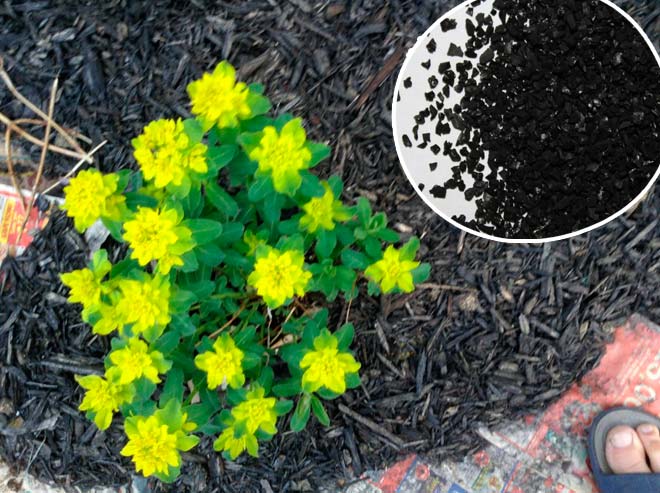
As with other garden plants, it is not recommended to use soils with a high nitrogen content for planting milkweed. In such conditions, the risks of tissue decay increase.
Home care
Caring for a Milkweed indoor bush is not very difficult. It is enough to water it on time, feed it, replant it as needed.

Watering
When the top layer of the soil dries up, the plant is watered. The bush should not be flooded too much, but the moisture should be of high quality - under the main stem of the plant. The water temperature for irrigation is selected at room level (or slightly cooler). The plant does not tolerate dry soil and air - under such conditions, it must receive a sufficient amount of moisture. In summer, Mila spurge is watered 2-3 times a week, and in winter - as needed, when the topsoil dries out.
Important! When watering some plants, do not allow water to enter the leaves and base of the stem. In this way, the formation of fungi can be avoided.
Top dressing
You need to feed the bush every month during the period of active growth - in spring and summer. Any feeding for cactus and succulent plants is used, which includes nitrogen, phosphorus, potassium, calcium. Fertilizers are applied in a small amount under the base of the stem, and after 1-2 hours the plant is watered.

Pruning
The formation of a milkweed bush is carried out at the request of the owner. You can let everything go by itself and let the plant lose its shape, or you can form a beautiful crown for this succulent. How to cut the shoots, each grower decides for himself. Usually, the branches are shortened by a third, and the withering, drying, old shoots are completely removed. The crown after trimming should have a semblance of spherical and look fresh and well-groomed.
Transfer
Due to the weakness of the root system, a planned plant transplant is performed with extreme caution. Given the low growth rates of this species, it is worth replanting once every 2-3 years.
The new pot is only taken one "size" larger. It is also worth planning in advance how and with what to root Mil's euphorbia in a new container.
You will need a high-quality substrate in the form of sod land and small pebbles. The transplant is carried out in the spring, so that the plant has time to root well over the summer before the winter dormant period. To give stability and as a drainage, a layer of expanded clay and 1-2 large stones are laid on the bottom of the flower pot.
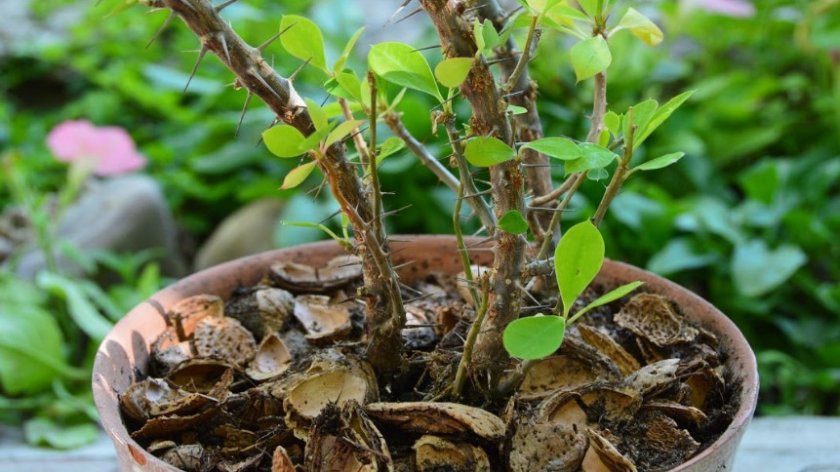
Landing time and technology
Planting this variety of succulents is best done in the second decade of May, when the probability of frost is minimized. In the southern regions, where spring usually comes earlier, work can be carried out from the second half of April, focusing on the average air temperature.
Planting procedure:
- Be sure to loosen the soil. Liming is carried out if the soil is acidic.
- Dig holes up to 10 cm in diameter. The bottom of each must be covered with drainage, for which you can take a mixture of expanded clay and pebbles. On top, the drainage layer is sprinkled with compost, the layer thickness must be at least 2 cm. Use dry bark for compost.
- Dip the sprouts into the hole, level the roots, sprinkle with a mixture of earth, to which sand and peat have been added.
- Young shoots are very thin, bend easily, so it is necessary to build a support. You can use wood or other sticks.
Preplant tillage is usually not carried out. The main condition is that the earth should not be oversaturated with nutrients. Aerate to improve air and moisture access.
If water collects at the landing site, it is necessary to choose another site or build a drainage system. When planting seedlings, observe the interval between them from 40 to 60 cm. The plant lives in one place for a maximum of 6 years, and in the first year it develops more slowly, the flowering is weak. Only in the third year the bush fully enters into force. The culture grows poorly in excess moisture, practically does not bloom and may die.
Milkweed breeding methods
Mil's spurge is propagated by seeds, division of the mother bush and cuttings.
Seed breeding method
For cultivation of a flower, milkweed seeds are purchased in a garden center or flower shop.
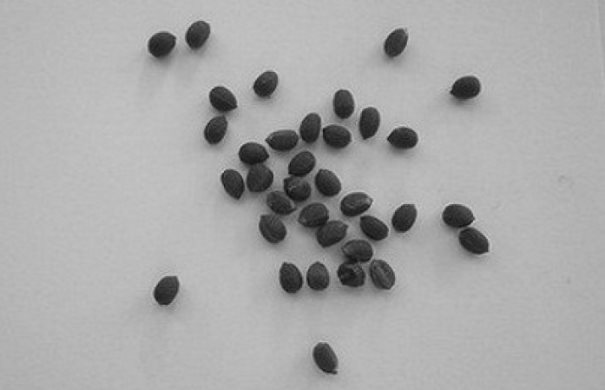
The soil is abundantly watered. Containers with seedlings are covered with a film After the appearance of 2-3 leaves, young shoots are planted in different pots.
When propagating a home flower with seeds, it must be remembered that the characteristics and properties of the parent variety will be lost.
By dividing the bush
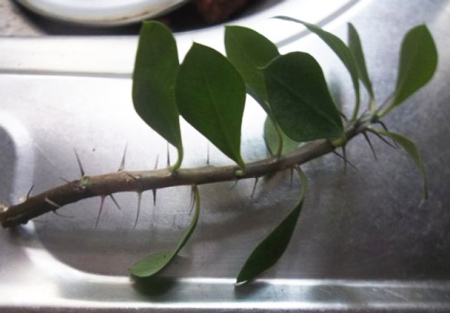
Only a specimen that has several trunks and a massive root system is suitable for division.
This will allow the split parts to take root quickly.
In order to divide the bush, you need to remove it from the pot, free the roots from the ground, carefully divide the plants into several parts. It is necessary to divide so that on each part a process is preserved. After that, each part must be planted in a separate pot with soil mixture.
Propagation by cuttings
Reproduction by cuttings is carried out in mid-spring. Watch a video on rooting milkweed cuttings.
To root cuttings: 1. The upper part of the strongest shoot, 10-12 cm in size, is cut off from the mother plant. The stalk is treated with an antibacterial agent and placed in a container with water. 3. As soon as a film forms at the cut sites, the cuttings are planted in fertile peat-based soil. If necessary, young plants are treated with a growth stimulant. 4. The planted flower is watered abundantly and placed in a warm, well-lit place. 5. After 12-16 days, the plant takes root and can be replanted to a permanent location.
Important! When working with Milkweed, do not forget about safety methods and protection against the ingress of poisonous substances on the skin.

